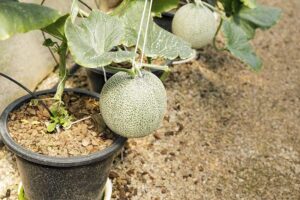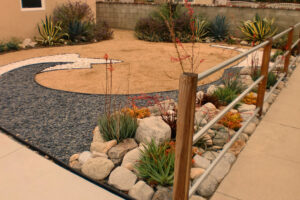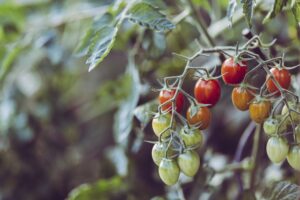
I.. Introduction
A. Exploring the Possibility of Container Gardening for Cantaloupes
Cantaloupes, with their juicy sweetness and refreshing flavor, are a delightful addition to any garden. While traditionally grown in sprawling fields, the idea of cultivating cantaloupes in containers is gaining traction among urban gardeners and those with limited outdoor space.
B. Benefits of Growing Cantaloupes in Pots
Container gardening offers several advantages for cultivating cantaloupes, including greater control over soil conditions, enhanced mobility, and the ability to optimize growing conditions for maximum yield and quality.
II. Selecting the Right Container and Location
A. Container Requirements
1. Size and Depth
Cantaloupes have extensive root systems and require ample space to grow and thrive. When selecting a container, opt for one that is at least 18 inches deep and wide enough to accommodate the sprawling vines of the cantaloupe plant.
2. Drainage Holes
Proper drainage is essential for preventing waterlogged soil, which can lead to root rot and other issues. Choose a container with multiple drainage holes at the bottom to ensure excess water can escape freely.
B. Ideal Location for Cantaloupe Containers
1. Sunlight Exposure
Cantaloupes thrive in full sun, requiring a minimum of 6 to 8 hours of direct sunlight per day for optimal growth and fruit development. Place your containers in a sunny spot, such as a south-facing patio or balcony, to provide sufficient sunlight for your cantaloupe plants.
2. Shelter from Wind
While cantaloupes enjoy plenty of sunlight, they can be susceptible to damage from strong winds, which may break delicate vines or dislodge developing fruit. Position your containers in a sheltered location or provide wind protection with trellises or nearby structures.
III. Soil Preparation and Planting
A. Choosing the Proper Soil Mix
1. Well-Draining Medium
Use a lightweight, well-draining potting mix specifically formulated for container gardening. Avoid heavy soils that retain water, as they can lead to root rot and other moisture-related issues.
2. Nutrient-Rich Composition
Cantaloupes are heavy feeders and require a nutrient-rich soil to support healthy growth and fruit production. Incorporate organic matter, such as compost or aged manure, into the potting mix to provide essential nutrients for your cantaloupe plants.
B. Planting Cantaloupe Seeds or Seedlings
1. Sowing Depth and Spacing
Plant cantaloupe seeds or seedlings at the appropriate depth, typically around 1 inch deep, and space them at least 12 to 18 inches apart to allow ample room for growth. If planting multiple seeds in the same container, thin seedlings to the strongest one per spacing recommendation.
2. Watering and Mulching Techniques
Water newly planted cantaloupe seeds or seedlings thoroughly to settle the soil and promote root establishment. Apply a layer of mulch, such as straw or shredded leaves, around the base of the plants to conserve soil moisture and suppress weed growth.
IV. Care and Maintenance of Cantaloupe Plants in Pots
A. Watering Needs and Moisture Management
1. Avoiding Overwatering
Cantaloupes prefer consistent moisture but are susceptible to root rot if subjected to waterlogged conditions. Allow the top inch of soil to dry out between waterings, and adjust your watering schedule as needed based on environmental factors and plant growth.
2. Monitoring Soil Moisture Levels
Check the soil moisture level regularly by inserting your finger into the soil near the base of the plants. If the soil feels dry to the touch, it’s time to water. Avoid watering overhead to prevent wetting the foliage, which can increase the risk of disease.
B. Fertilization and Nutrient Requirements
1. Balanced Fertilizer Application
Apply a balanced fertilizer formulated for fruiting plants according to the manufacturer’s instructions. Avoid excessive nitrogen, which can promote lush foliage growth at the expense of fruit production, and prioritize phosphorus and potassium for flowering and fruit development.
2. Supplemental Nutrient Boosts
Periodically supplement your cantaloupe plants with additional nutrients, such as compost tea or fish emulsion, to support healthy growth and fruit set. Apply foliar sprays or root drenches as needed to provide a nutrient boost during periods of rapid growth.
C. Pruning and Support for Cantaloupe Vines
1. Training Vines Upward
Encourage vertical growth and save space by training cantaloupe vines to climb trellises or vertical supports. Secure vines gently with soft ties or twine to prevent damage and promote upward growth.
2. Removing Excess Foliage
Prune cantaloupe plants as needed to remove excess foliage and promote air circulation around the developing fruit. Focus on removing dead or diseased leaves, as well as any runners or suckers that detract from the main vine’s productivity.
V. Harvesting and Enjoying Homegrown Cantaloupes
A. Signs of Ripeness and Harvesting Techniques
1. Color and Texture Indicators
Monitor your cantaloupe plants closely for signs of ripeness, including a change in color from green to beige or yellow and a sweet, fragrant aroma. Press gently on the stem end of the fruit – ripe cantaloupes will yield slightly under pressure.
2. Harvesting with Care
Use clean, sharp shears to cut ripe cantaloupes from the vine, leaving a few inches of stem attached to the fruit. Handle harvested cantaloupes gently to avoid bruising or damaging the delicate skin.
B. Storage and Preservation Tips
1. Proper Storage Conditions
Store freshly harvested cantaloupes at room temperature for 1 to 2 days to allow them to fully ripen. Once ripe, refrigerate cantaloupes in a perforated plastic bag to maintain freshness and flavor for up to 5 days.
2. Enjoying Fresh Cantaloupes
Slice ripe cantaloupes into wedges or cubes and enjoy them fresh as a healthy snack or refreshing addition to salads, smoothies, and desserts. Experiment with different flavor combinations and culinary techniques to savor the sweet, juicy goodness of homegrown cantaloupes.
In conclusion, while cantaloupes traditionally thrive in open fields, they can also be successfully grown in containers with proper care and attention. By selecting the right container, preparing the soil, and providing adequate support and maintenance, you can enjoy a bountiful harvest of sweet, juicy cantaloupes right from your own patio or balcony. With the right techniques and a little bit of patience, container-grown cantaloupes can be a rewarding addition to any garden, regardless of size or space limitations.






